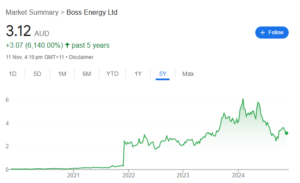2024 has not been a great year for investing in uranium, but will yellowcake rebound in 2025 and which companies will perform?
![]() Ujjwal Maheshwari, November 11, 2024
Ujjwal Maheshwari, November 11, 2024
Those who made the choice to invest in Uranium have endured a challenging year. Despite the fluctuating demand, economic pressures, and heightened scrutiny over the material, Uranium is still a highly sought-after metal in the nuclear and clean energy landscape.
Certain companies are positioned to benefit as they approach Uranium production. One such standout is Boss Energy (ASX: BOE), a newly-minted producer advancing its operations at its Honeymoon project in South Australia. With uranium prices predicted to rise in the coming years due to growing interest in clean energy sources, Boss Energy’s strategy and near-term production plans make it an interesting case study for investors.
Why hasn’t it been a good year for investing in uranium?
Uranium, like every commodity in the market, had its ups and downs.
Demand Fluctuations
In 2024, uranium experienced sharp hikes and drops due to inconsistent demand patterns. While the world is increasingly turning towards developing nuclear energy as part of the transition to low-carbon sources, the pace of this shift remains uneven across different regions. Factors like policy shifts in different countries, energy market volatility, and ongoing concerns over nuclear power’s role have caused demanding growth.
Prices of Uranium
Uranium prices had a volatile year. It struggled to maintain its upward trajectory but retained a gradual growth. The spot price for uranium hovered around $50–$55 per pound for much of 2024. This is considerably lower than the levels needed to enhance broader industry investment in new mines and production. However, nuclear plant closures and active market demand showed that there could be a way for uranium to make a solid comeback.
The False Dawn
Just prior to the GFC, yellowcake prices were at the end of a frenzied bull market that saw prices skyrocket from around US$10/lb to US$140/lb. It was part of a run in commodities generally but there were also factors specific to the market. These included interest in nuclear power by Western governments after the insecure nature of Russian and Middle Eastern oil became apparent once more and the 2006 flooding of the Cigar Lake Mine in Saskatchewan.
The GFC put an end to the commodities bull market generally. And Fukashima terrified the world against any form of nuclear power. The tragedy with prices remaining so low is that many good projects held by ASX companies had to be mothballed. Many remain so to this day or are just being bought into production now.
In 2023, prices rallied to levels not seen since the GFC and investors were optimistic that the industry was returning to what it was before. But 2024 have seen prices retreat, and investors have become pessimistic again.
Some uranium companies are persisting – like Boss Energy
Despite uranium’s mixed performance, some companies have persisted with their efforts to bring projects into production. Boss Energy is one such company, and it has managed to maintain strong investor interest. The company’s flagship project, the Honeymoon Uranium Project in South Australia, is on track to begin production shortly. This positions Boss Energy to capitalize on the potential uranium price rebound. As other players are currently involved in new uranium mines and projects, Boss Energy’s project is way ahead of the game.
This project stopped its production in 2013 due to the low prices of Uranium. Boss Energy acquired this project in 2015, envisioning restarting the operations once the market improves.
The Honeymoon Project
Honeymoon’s resources and infrastructure position it to be a low-cost uranium producer in the country. The project has an estimated All-In Sustaining Cost (AISC) of $25–$27 per pound, which is significantly lower than current uranium prices. This suggests substantial profit margins for the company once production begins.
Honeymoon boasts a resource estimate of 71.6 million pounds of uranium oxide (U3O8). This ensures long-term production potential for the company in the market. This is a considerable resource size that can sustain production for several years into the future.
Boss Energy’s strategy for the Honeymoon project focuses on a restart strategically divided into phases. Phase 1 will target an initial annual production of 2.5 million pounds of U3O8, with potential expansions to follow as demand and prices stabilize. This approach minimizes initial capital expenditures on uranium while allowing Boss Energy to ramp up production to serve favourable market conditions.

Boss Energy’s Growth Strategy
Boss Energy’s ability to bring a production-ready project online provides it with a first-mover advantage in Australia’s uranium sector. This timing of the company aligns well with projected demand growth in the nuclear sector. As governments all over and companies commit to reducing carbon emissions, the company is well-positioned to cater to yellowcake demand.
Boss Energy is also looking to secure partnerships and supply agreements with other major companies to support steady uranium sales upon production. Over the past couple of years, the company has announced that it had signed off-take agreements with global utilities to supply uranium. This assures demand and revenue from uranium once production commences from its project.
While initial production targets are modest, Boss Energy has indicated expansion plans. The company’s strong cash position will allow it to increase production capacity or explore further assets in Australia, positioning itself as a long-term uranium supplier.
Boss Energy’s Key Financial Highlights
Boss Energy’s financial performance reflects its upward growth trajectory. In FY24, the company reported an operating loss because of the pre-production status of its project. The company allocated substantial funds on capital towards advancing its Honeymoon project. The exploration and development expenses for the same make up a significant portion of its spending. By the end of FY24, Boss Energy held cash reserves of around $125 million. This reflects a solid financial position of the company that provides a buffer as it nears the production stage.
Given that Boss Energy has not yet commenced production, it has not reported revenue from uranium sales. However, the company’s balance sheet remains healthy due to effective financing and capital raises which are strategically planned by the company.
Boss Energy reported a net loss of approximately $15 million in FY24, which is common for companies in their pre-production phase but it demonstrates Boss Energy’s commitment to progressing its Honeymoon project without generating immediate income from it.
Boss Energy’s Road Ahead for FY25 and Beyond
As uranium market conditions gradually improve, Boss Energy is well-positioned to meet this demand. Its Honeymoon project will offer immediate supply into the market. This could potentially benefit from any price increase as nuclear energy gains traction as a sustainable alternative to fossil fuels.
With many governments opting for nuclear energy, Boss Energy’s close production phase will come in handy to serve the global demand for Uranium. Analysts predict that the uranium demand could grow at a compound annual growth rate (CAGR) of around 3-4% over the next decade. This is mainly driven by nuclear energy adoption in large countries like China, India, and the Middle East. This expected demand increase could push uranium prices above the current range, thus benefiting low-cost producers like Boss Energy.
What about other uranium stocks?
Another one we like is Peninsula Energy (ASX:PEN). Its flagship Lance project lies in Wyoming, USA and it is undergoing final construction before production starts again.
It is one of the largest US uranium projects with 53.7Mlb of JRC Resources. The conservative DFS, estimated a 14-year mine life generating 14.4Mlb, deriving a 43% pre-tax IRR, US$895.2 project revenue across the life of the project and a US$124.8m pre-tax NPV.
We also note that it will produce with the low-pH ISR method to produce. The method involves recovering minerals from a suitable orebody before dissolving them and pumping the solution to the surface where the minerals can be recovered, thereby generating no tailings or waste rock. This means the project, which is the only US project authorised to use this operation. will be a low-cost operation. There may be further upside from exploration work conducted at the project.
Count in the Risks
Uranium prices have been historically volatile. The unstable prices associated with the material often caused concerns among investors looking to invest in the energy sector. Any unexpected shifts could impact Boss Energy’s production.
A possible delay in restarting production from the Honeymoon project will hinder Boss Energy’s ability to capitalize on these favourable market conditions. Certain regulatory changes need to be followed by the miners in Australia. These environmental regulations can impact operational costs and project timelines of production.
Final Thoughts
In a challenging year for uranium, certain developers have persisted with their long term vision. Boss Energy and Peninsula Energy are two such companies as they restarts operations at the Honeymoon and Lance projects. With a clear focus on cost efficiency, a strong resource base, and a first-mover advantage, these companies are positioned to benefit from the global demand for uranium as it picks up, and companies that follow its lead may too
What are the Best ASX Stocks to invest in right now?
Check our buy/sell tips
Blog Categories
Get Our Top 5 ASX Stocks for FY26
Recent Posts
Electric Optic Systems (ASX:EOS) Lands Major $120M Asia Military Contract, Is It Time to Buy?
EOS Fires Up Second High-Energy Laser Sale Electric Optic Systems (ASX:EOS) is moving toward a potential partnership with a South…
SpaceX’s $1.5 Trillion-Dollar Lift Off in Potential 2026 IPO
SpaceX Ignites a Trillion-Dollar Push to Reach Mars by 2028 SpaceX is edging closer to what could be the first…



